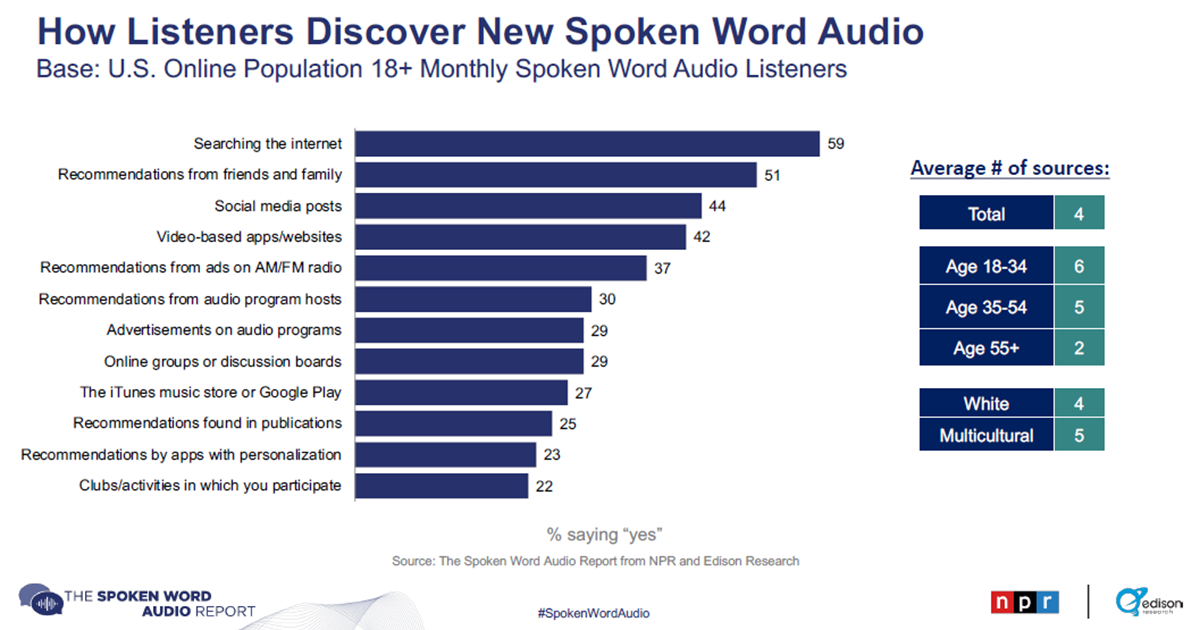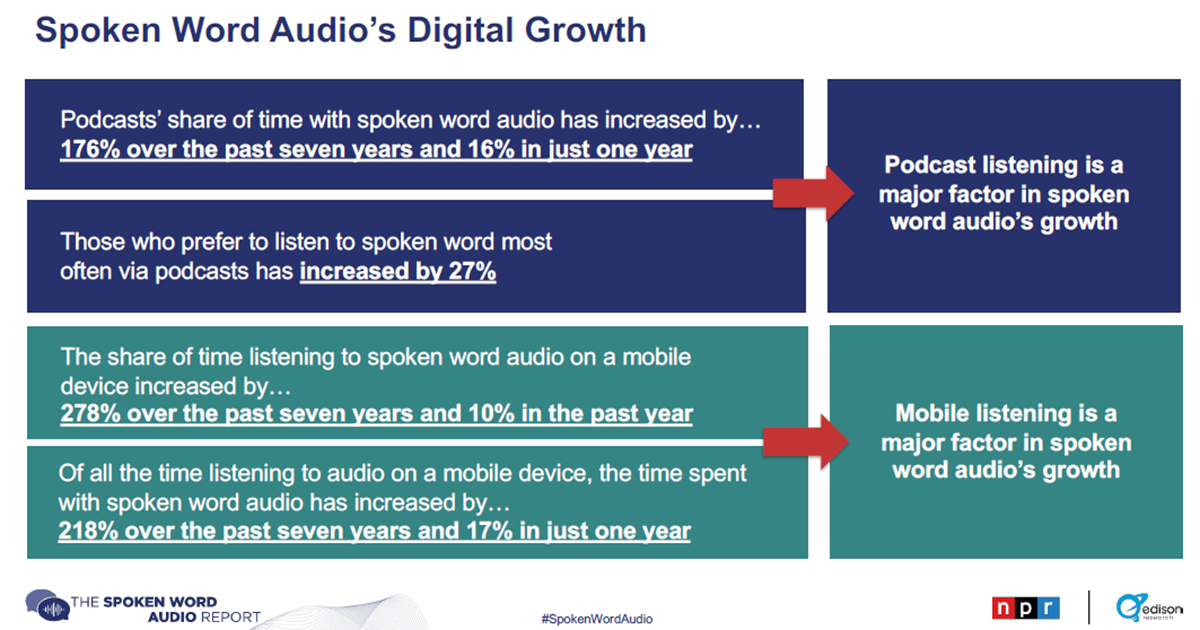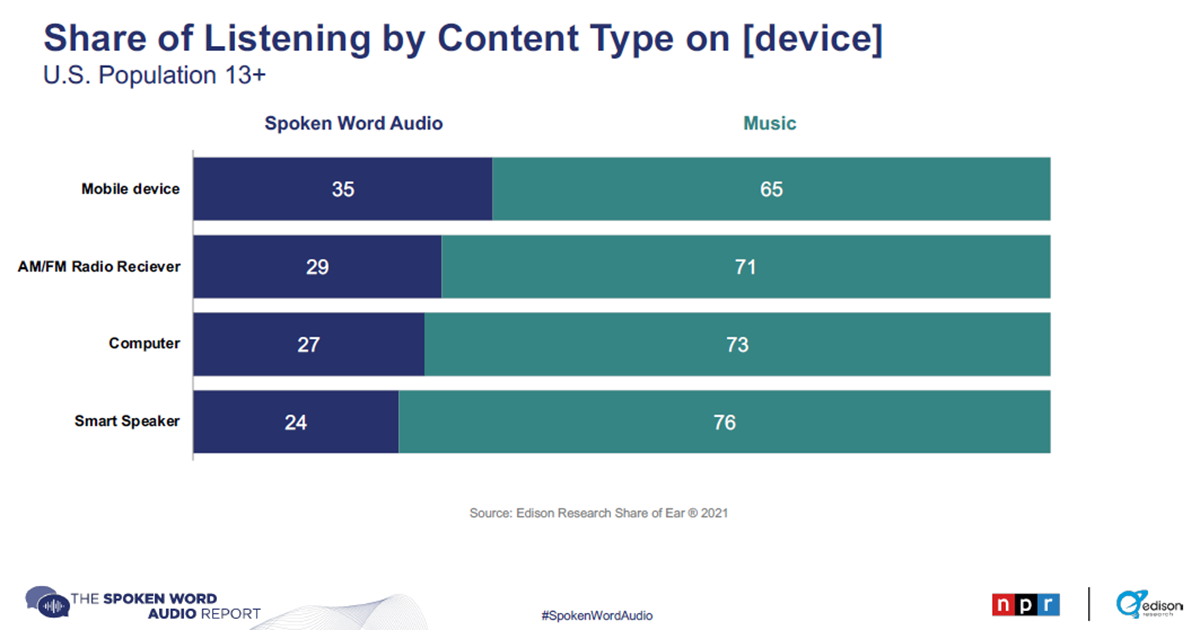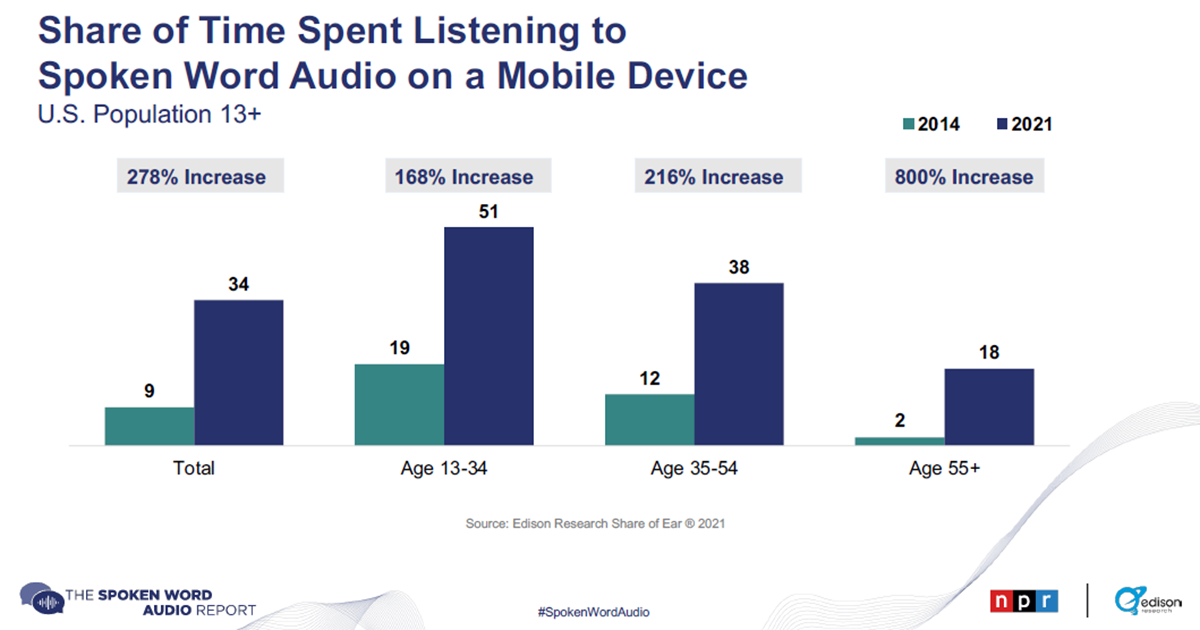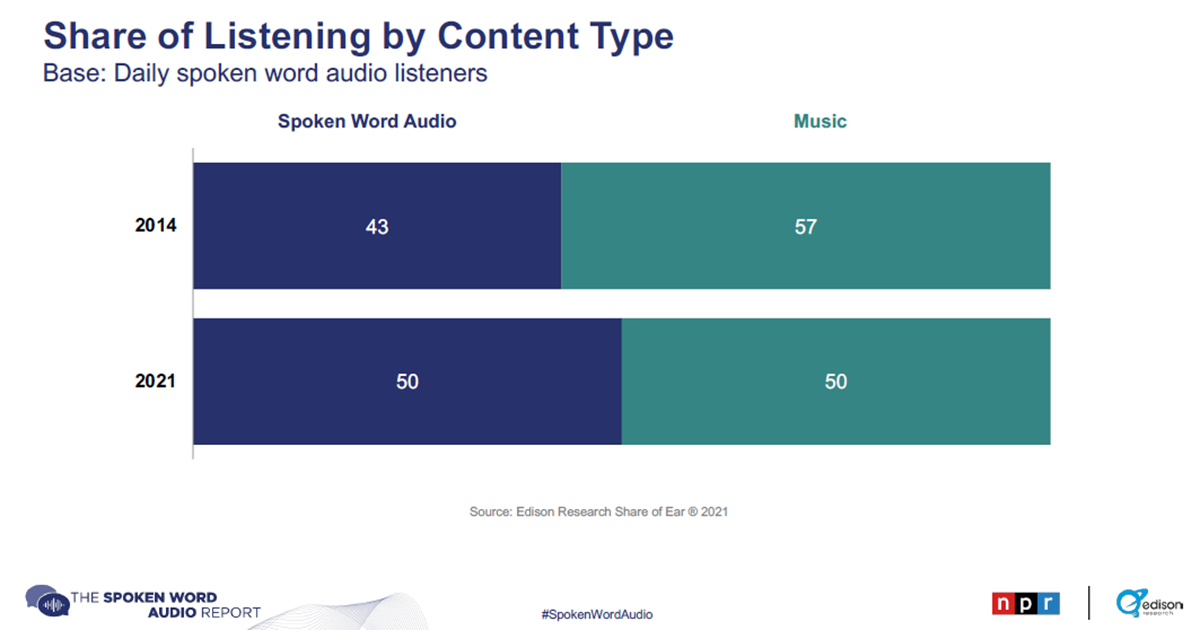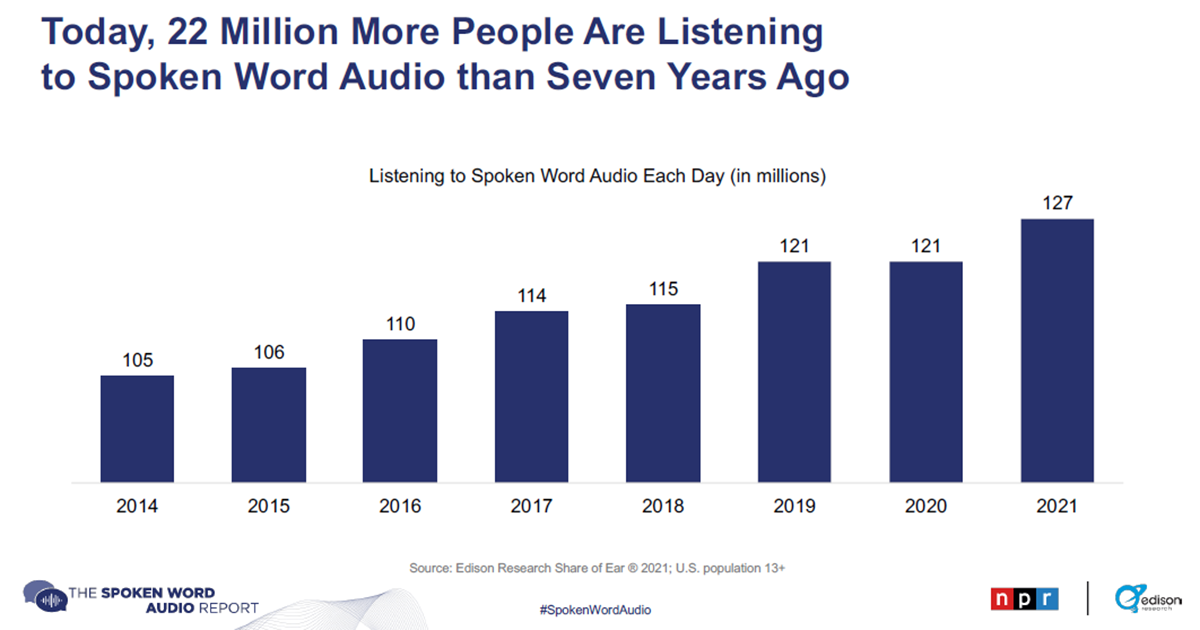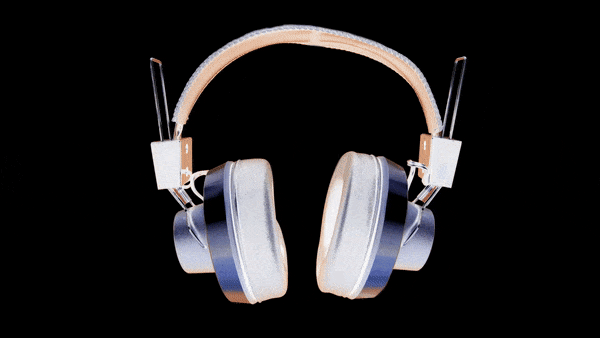
Spoken word audio is starting to take audience share from traditional music programming on the radio. That’s according to a recent report from Edison Research and National Public Radio.
Edison offers three key findings for The Spoken Word Audio Report 2021, part of the researcher’s Share of Ear series of audio listening surveys. (These stats apply to the U.S. only.)
Spoken word audio is generally defined as news, sports, talk, information, audiobooks and podcasts.
The report notes spoken word’s “share of audio listening has increased by 40% over the last seven years; 8% this year [2021].” It points to this growth being “driven by large increases in young and multicultural audiences.”
As to the motivation of listening, most respondents “cite the ability to multitask [as] one of the main motivations for spoken word audio listening, [but] young and multicultural audiences are more likely to cite other reasons such as connection, education, new perspectives, self-improvement.”
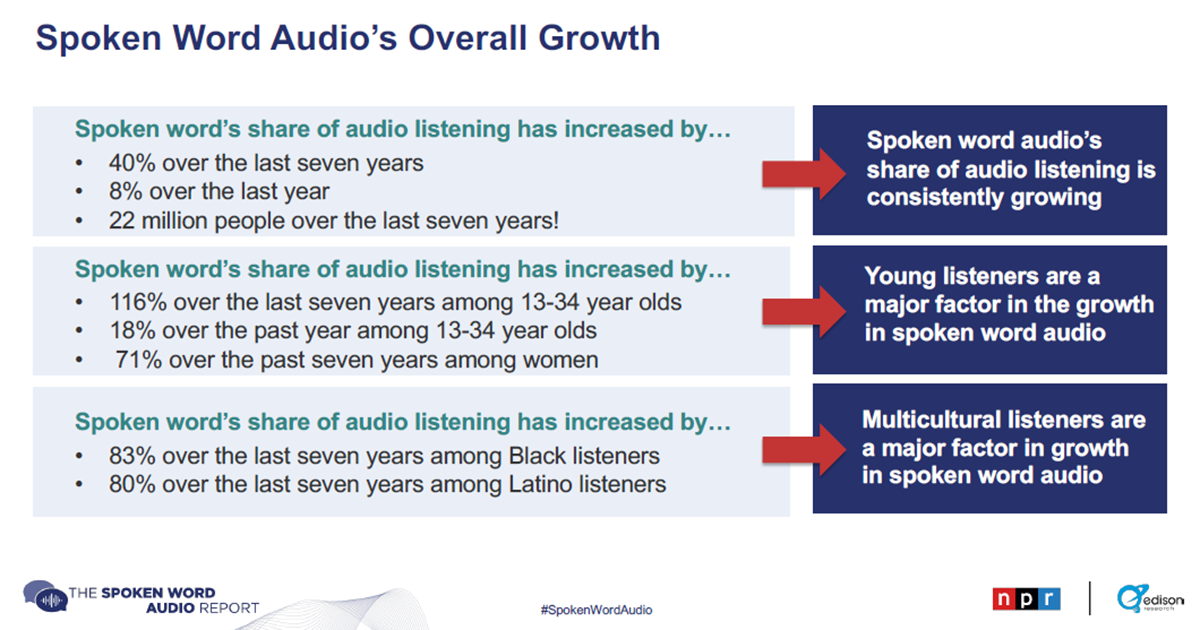
Edison picks out these results:
- Black listeners spend 22% of their audio time with spoken word (an 83% increase over 2014)
- Hispanic/Latino listeners spend 27% of their audio time with spoken word (an 80% increase over 2014)
- White listeners now spend 29% of their audio time with spoken word, a 26% increase over 2014.
The survey provides a great deal of info on why people are listening to spoken word content, along with doing a through job of demographic break down and identifying device usage.
Edison Research Vice President Megan Lazovick said, “What stands out from this research is the use of spoken word audio for intrapersonal needs. The young listeners I spoke with turn to spoken word audio for help navigating life’s problems, making meaningful connection, and discovering new points of view — spoken word is, for some, an antidote to a superficial social media world.”
Spoken word is, for some, an antidote to a superficial social media world.
Edison Research VP Megan Lazovick
Not Quite All Things Considered
There may be some caveats warranted here. Like all surveys and polls, an almost microscopically small “sample” is projected to represent the whole country. The accuracy of the survey is dependent upon the accuracy of the original sample. The Spoken Word Audio Report 2021 results were derived from an online survey of “1,000 U.S. adults age 18 and older, conducted August 18–30, 2021,” who kept a one-day diary of their audio listening habits. All participants “reported listening to spoken word audio in the last month.”
In addition, many polls consist of self-selecting participants who enjoy attention and sharing their opinions. Furthermore, this one might have a disproportionately large number of urban, minority, NPR listeners in it, so it would not be surprising that the poll strongly reflects NPR’s content.
Adding to that, judging by the smaller number of respondents who listen to sports and religious programming and the large number who chose food and comedy/humor (famously poor performers in traditional radio), the surveyed sample may be demographically narrow.
Nits aside, the growth of spoken word programming is undeniable as people have been spending more time cooped up in their homes rather than being outside, with friends or in an office setting wherein listening to the radio or another device might be frowned upon.
Co-sponsor of the survey, NPR, conducted a webinar to discuss the report:
The 2021 Spoken Word Audio Report can be viewed and downloaded via NationalPublicMedia.com.
Not All COVID’s Fault?
Like many other behavior shifts in recent years, the COVID-19 pandemic may take responsibility for driving at least some spoken word audio listening.
Specifically, “disruptions in routines and habits actually helped grow the intake of audio content, also affecting where most listening is happening — home,” Ron Jaworski of Trinity Audio writes.
The pandemic drove an increase in news consumption (likely reflected in these results), but COVID-19 is far from the only factor influencing what we’re listening to, where and how.
For example, Jaworksi points out that some publishers are utilizing technology to share and even create audio content in new ways.
For example, he notes that all of McClatchy’s 30 markets have added Trinity Audio’s text-to-speech feature to their websites. According to a press release, the 2020 pilot program increased time on site for the Sacramento Bee and The News & Observer, while also building loyalty (more visits per user, more articles viewed per visit).
PODCASTING & DIGITAL AUDIO — WATCH THIS SPACE:
Podcasting continues to be one of the fastest growing channels in digital media. Advertising revenue attained a new high in 2021, racing past the $1 billion mark for the first time ever to reach $1.4 billion. Revenues are expected to almost triple by 2024 to more than $4 billion, making it clear that podcasting and digital audio aren’t slowing down anytime soon. Gain insights into this burgeoning medium with a selection of articles hand-curated from the NAB Amplify archives:
- The Podcast Advertising Market Tops $1 Billion for the First Time
- Why the Podcast Medium Keeps Shapeshifting
- Understanding the Podcast to TV Pipeline
- Has the US Hit Peak Podcasting?
- When Podcasting Collides with Commercialization
Importantly, the feature also adds a new revenue source for the challenged newspaper industry; the AI-generated “audio articles” include ads that are also automatically inserted.
According to Jaworski, “Audio articles tend to be listened to all the way through, as opposed to text articles that have much quicker drop-off rates due to the reader’s ability to quickly skim through it.”
Of course, radio broadcasters have been telling us that listeners are among the most engaged constituents for eons, so they won’t be surprised by any of this.
READ MORE: Spoken Word Audio Is Stronger Than Ever: The How and the Why (Trinity Audio)
McClatchy is far from alone in offering in-browser listening options for subscribers. Forbes, Harvard Business Review, The Economist, The New Yorker have all added this inclusive option as a way to up time on site via TSL (time spent listening).
Nieman Labs’ Gabe Bullard reported on the trend in an article that you can either read or listen to.
Perhaps what might be most counterintuitive about the move to offer narrated articles in a podcast crazy environment is how technically simple it can be to meet listeners’ expressed needs.
Narrated articles may not offer the most robust listening experience, but they do offer one that’s convenient.
Gabe Bullard
Bullard notes, “In an age when many podcasts offer dramatic storytelling and sophisticated audio, narrated articles may not offer the most robust listening experience, but they do offer one that’s convenient for listeners and for the magazine: The audio articles serve people who are too busy to read but want to know what’s on Zetland [a Danish outlet that offers narrated articles] that day.”
But of course, there’s an argument to made that listeners will appreciate it when outlets offer content beyond the bare minimum needed to convey the information.
If a newsroom has the skills to produce a narrated article with true sound design and a featuring a practiced narrator, so much the better, Bullard argues.
“The sound design that accompanies a documentary-style podcast or a radio news report is a craft that, like writing, can be appreciated on its own terms, but is also meant to help people understand a story and pay attention to it.” (Sounds like a growth industry for experienced audio creators and voiceover talent!)
READ MORE: Audio Articles are Helping News Outlets Gain Loyal Audiences (Nieman Labs)
The trend also goes one step further (away from publishers’ websites). There’s Audm, an app dedicated to longform journalism in audio form. It features content from Buzzfeed, the New York Times, London Review of Books, Wired, and many others, billing itself as an app for those who don’t have the time to read.
Curio is the UK’s answer to Audm, and Ireland’s Noa (which stands for “news over audio”).
Spoken Word Audio in the UK
Across the pond, Radio Joint Audience Research, commonly referred to as RAJAR, has updated its U.K.-focused listening stats for the first time since 2020. (The organization hit the pause button on its studies during the height of the pandemic, and then debuted a new measurement methodology in Q3 of 2021.)
The trend toward at-home audio consumption is the same in the British Isles as in the U.S. An uptick in online/app-based listening is also consistent with the RAJAR findings in their Winter 2021 MIDAS report, which surveyed those 15 and older.
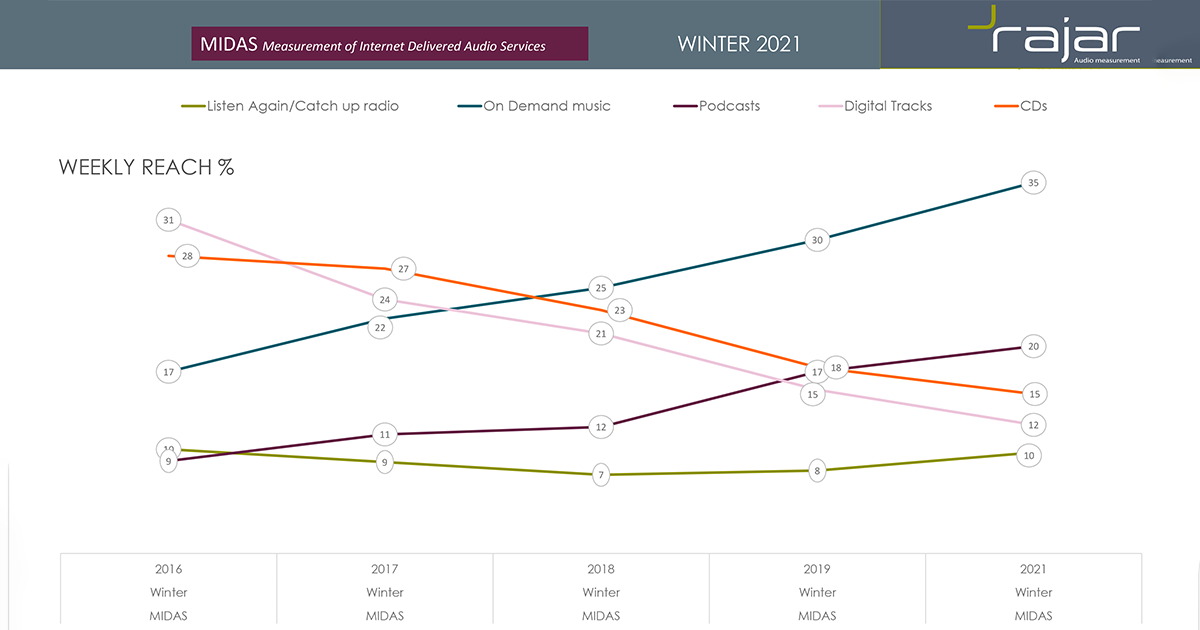
On the whole, UK residents say they favor on-demand music over spoken word audio in the form of podcasts or catch up radio. However, podcasts are gaining traction and listen again radio remains flat, while listening to digital tracks (think iTunes) and CDs are on the downswing.
However, “catch up” or “listen again” radio (the Brits’ term for audio on-demand versions of OTA content offered online) does not fare well against on-demand music (OMS), and it is inched out by podcasts in most demographic groups. Nonetheless, the report indicates that live radio listening is alive and well in Great Britain, favored by both the youthful and the aged.
You can read the full survey results at RAJAR.co.uk.
Emily M. Reigart also contributed to this story.



